
Application of Z Score Model for Financial Health Checkup: A Case Study of TATA Consultancy Services Ltd.
Abstract :: Table - I Table - II Table - III Table - IV Table - V Table - VI
Various stake holders such as bankers, financial institutions, investors, employees, government etc. need to know about the financial health of the business. For arriving at the conclusions about the financial health of any business, there are several tools available. Out of all of them ratio analysis is one of the most widely used tool. Despite ratio is a powerful tool, combining different ratios into a single measurement is not possible. Prof. Edward I. Altman has made an effort to combine these ratios into a single model. This model is popularly known as ‘Z score model’ which is used to predict financial health of the business. We have attempted to apply Z score model to check the financial health of TCS, one of the leading I.T. Company. The analysis showed the best results of the company in terms of liquidity, profitability, long term solvency, operating efficiency and sales generating capacity.
Key Words:-Financial health, Ratio analysis, Single measurement, TCS, Z score
1. Introduction :
Preparation of financial statements is an important task for any business. With the help of these financial statements, the business can communicate about several aspects about the financial health of the business. Various stake holders are interested in knowing about the financial health of the business. These stake holders can be classified into two categories viz. internal and external. Internal stake holders such as employees, executives, various levels of management use the financial statements for various purposes. External stake holders such as investors, credit agencies, government agencies, bank, financial institutions, other creditors etc. are interested in financial statements to know about the financial soundness of the business. In order to arrive at the conclusions about the financial soundness of the business the users of financial statements apply various tools of financial analysis such as comparative financial statements, common-size financial statements, trend percentages, fund flow and cash flow analysis and ratio analysis. Out of all these tools of financial statement analysis, ratio analysis is the widely used tool because of its efficiency and effectiveness of arriving at the conclusions about the financial soundness of the business.
2. Z score model- An introduction:
As we know that there are several tools available for financial statement analysis. All these tools are used by different financial analysts for the different purposes. So these tools do not serve any unique purpose of financial analysis. For example, ratio analysis involves several ratios that are used to analyze different situations of business. Hence accurate conclusions cannot be made about the financial soundness of the business. In this sense ratio analysis is a weak tool for the financial statement analysis. To remove this weakness William H. Beaver, in 1967, selected five ratios out of total 30 financial ratios to study the financial health of the business. He took the sample of 79 successful units and 79 unsuccessful units. He applied five ratios i.e. cash-flow to total debt, net income to total assets, total debt to total assets, net working capital to total assets and current assets to current liabilities and used univariate analysis for making conclusion about the financial health of these successful and unsuccessful units.
Since the analysis made by Beaver was univariate analysis, it focused only single aspect of financial health of the business. The model developed by Beaver is not useful to analyze multi-dimensional aspects of the financial health of the business. To focus on multi-dimensional approach, Prof. Edward I. Altman, professor of finance at New York University, developed ‘Multiple Discriminant Analysis’ (MDA) which is popularly known as ‘Altman’s Z score model’. To prove this model, Altman took a sample of 66 corporations out of which 33 were bankrupt (distressed) and 33 were non-bankrupt (non-distressed). Through this analysis he proved that the Z scores of distressed corporations were lower than that of non-distressed corporations. On the basis of this analysis he set the benchmarks for identifying distressed, grey and safe zones of corporation’s financial health. His analysis proved to be very useful for the testing of financial health of the business. Now it is an internationally recognized model with wide universal acceptance along with frequent use by investors, Lenders and analysts. The Z score model was first published in September, 1968 titled “Financial ratio, Discriminant analysis and the prediction of corporate bankruptcy”, in Journal of Finance [23(4), pp. 589-609]. This model comprises of 5 multi-dimensional ratios viz.:
Z score is widely used tool to check the financial health of the business. This model is used by the analysts all over the world. To make it fit to the Indian perspective, Prof. K. B. Mehata has developed another model with some modifications in original Altman’s Z score model. Prof. K. B. Mehata’s model is known as “Altman’s modified model”. Here we have presented both the models in table form to develop an easy understanding about them.
Comparison of Prof. Altman’s and Prof. K.B. Mehata’s Z score model
A table showing explanation of variables used in Z score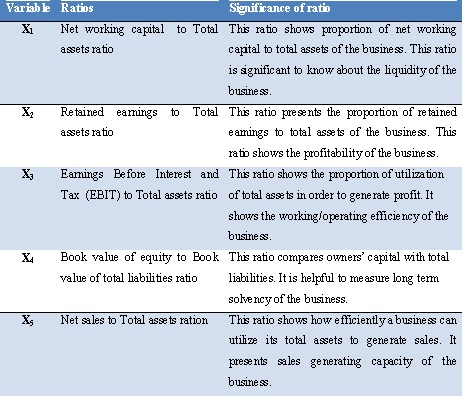
TCS belongs to I.T. industry. This is one of the leading I.T. companies in India. It is present at SENSEX, NIFTY and many more stock exchanges across the globe. The financial soundness of this company is remarkable. This fact is proved by its presence in Fortune India 500 (20th rank) and one of the most prestigious magazine Forbs. It is on the 701st rank out of global 2,000. The annual results of TCS, for the year ending 31st March, 2012, showed the remarkable growth in the profit. Here an attempt is made to analyze the financial health of TCS using Z score model (Prof. K. B. Mehata’s Model), for 8 consecutive years i.e. from 2004-’05 to 2011-’12. This is proved with the help of following data.
A table showing financial details of TATA Consultancy Services Ltd.*
[Rs. in Crores]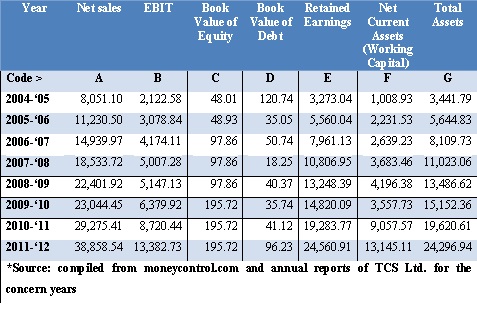
A table showing calculation of some important financial ratios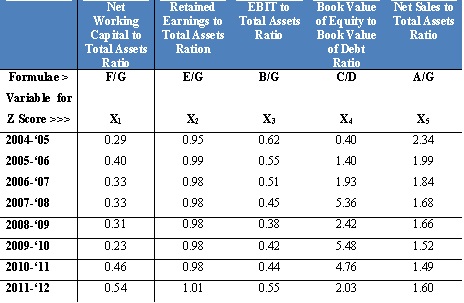
A table showing calculation of Z score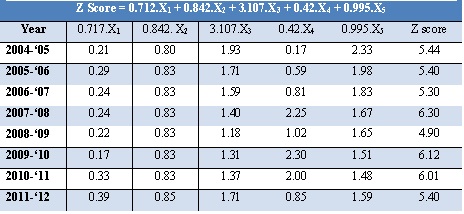
A tables showing interpretation of Z score for TATA Consultancy Services Limited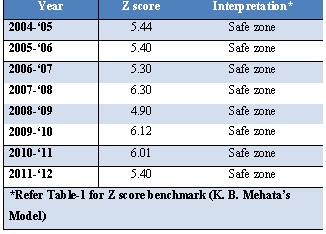
The results of Z score analysis show the soundest financial condition of the company. Company has been successful in maintaining liquidity, profitability, operating efficiency, long run solvency and investors’ confidence. The analysis proves that the financial condition of the company is in the safe zone while compared with Z score benchmarks.
REFERENCES :
***************************************************
Dr. Kamlesh M. Jani
Principal, P. D. Malavaiya College of Commerce, Gondal Road,
Rajkot- 360 004
Mob. 98255 94959
kmjani66@yahoo.co.in
Manish B. Raval
Assistant Professor
Lt. Shree M. J. Kundaliya English Medium Mahila Commerce & B.B.A. College, Rajkot
Mob. 98242 94341
manishraval810@gmail.com



Home | Archive | Advisory Committee | Contact us